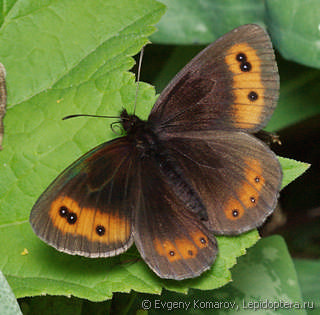Erebia aethiops

Taxonomy
class Insecta
Species name(s)
Erebia aethiops (Esper, 1777) = Papilio aethiops Esper, 1777 = Erebia aethiopella Warren 1937 = Erebia altaica Goltz 1930 = Erebia amplevittata Goltz 1939 = Erebia apenninicola Verity 1911 = Erebia binotata Popescu-Gorj 1955 = Erebia demarginata Popescu-Gorj 1955 = Erebia depupillata Steiner 1918 = Erebia eryphyle Hirschke 1911 = Erebia euryale Verity 1911 = Erebia enucleata Popescu-Gorj 1955 = Erebia infasciata Warren 1936 = Erebia ignotoides Warren 1937 = Erebia inocellata Owen 1952 = Erebia magdalena Kryzywicki 1963 = Erebia mesorubria Popescu-Gorj 1955 = Erebia perfusca-semicaeca Eisner 1946 = Erebia pupillifera Kollar 1938 = Erebia uralensis Goltz 1930. [9, 10, 187]
Scotch Argus.
urn:lsid:insecta.pro:taxonomy:8650
Expansion
This species marks on the maps: 3.
Zoogeographical regions
Palaearctic.
Russia regions
#7. Evropeisky yuzhno-tayozhny; #8. Evropeisky Tsentralny; #9. Evropeisky Tsentralno-Chernozyomny; #10. Sredne-Volzhsky; #11. Volgo-Donsky; #13. Zapadno-Kavkazsky; #14. Vostochno-Kavkazsky; #16. Sredne-Uralsky; #17. Yuzhno-Uralsky; #19. Sredneobsky; #20. Yuzhno-Zapadnosibirsky; #22. Krasnoyarsky; #23. Predaltaisky; #24. Gorno-Altaisky; #25. Tuvinsky; #26. Predbaikalsky.
Primary colors
Orange, Brown/Gray/Black.
Flight time
| January | February | March | April | May | June | July | August | September | October | November | December |
Larva lifespan
| January | February | March | April | May | June | July | August | September | October | November | December |

Detailed information with references
Distribution
Imago Habitus and Differences from alike species
General info about Imago
Imago lifespan
General info about Larva
Larva food plants / other food objects
Larva lifespan
Pupa
Subspecies of Erebia aethiops
- Erebia aethiops aethiops. [9]
- E. a. depressivaga Verity, 1935. [187]
- E. a. fogarisca Warren, 1931. [187]
- E. a. isolata Goltz, 1939. [187]
- E. a. jigodini Popescu-Gorj, 1955. [187]
- E. a. melusina Herrich-Schäffer, [1847]. [9]
- E. a. peneplana Berger, 1936. [187]
Authors
Initial species uploading to the site: Peter Khramov.
Text data: Peter Khramov.
The species characteristics formalization: Peter Khramov.
References
- [1] O. Karsholt, J. Razowski (eds.), 1996. The Lepidoptera of Europe: a distributional checklist
- [3] Каталог чешуекрылых (Lepidoptera) России. Под ред. С. Ю. Синёва. СПб.; М.: Товарищество научных изданий КМК, 2008
- [9] Tree of Life (funet.fi), 2012
- [10] de Jong, Y.S.D.M. (ed.) (2011) Fauna Europaea version 2.4 (faunaeur.org)
- [28] Moths and Butterflies of Europe and North Africa (leps.it), 2012
- [85] Lepidoptera species catalogue, Lepidoptera.ru, 2015
- [187] Species 2000, http://www.sp2000.org
Comments
Note: you should have a Insecta.pro account to upload new topics and comments. Please, create an account or log in to add comments
Erebia aethiops photos






















All the photos of the species in large size
Please, create an account or log in to upload your photo













































